Bryan L. Programmable controllers. Theory and implementation
Подождите немного. Документ загружается.

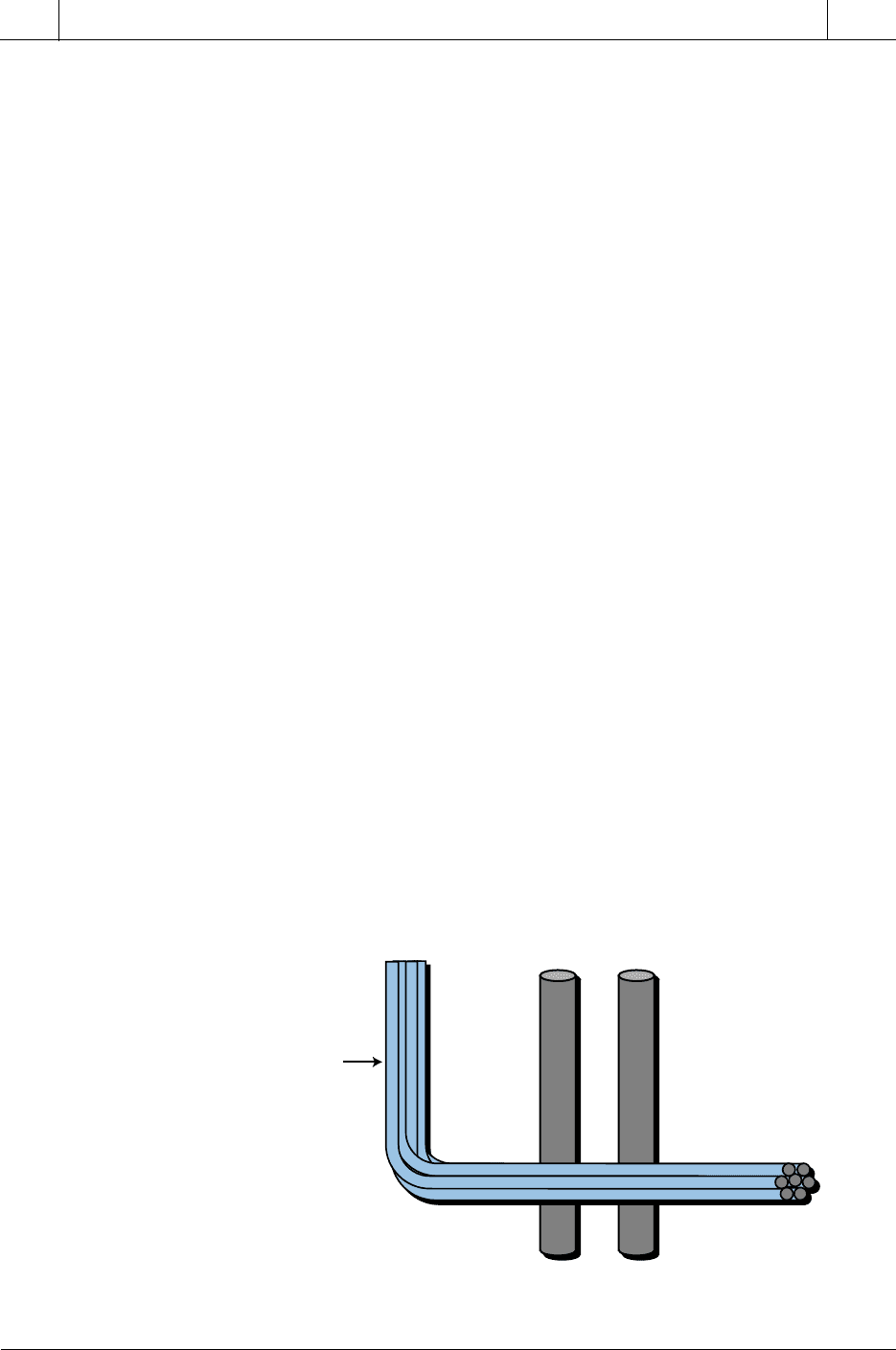
929
CHAPTER
20
PLC Start-Up
and Maintenance
SECTION
6
Installation
and Start-Up
Industrial Text & Video Company 1-800-752-8398
www.industrialtext.com
separated as much as possible within the rack. A suitable partitioning
would involve placing all AC modules or all DC modules together
and, if space permits, allowing an unused slot between the two groups.
Duct and Wiring Layout. The duct and wiring layout defines the physical
location of wireways and the routing of field I/O signals, power, and
controller interconnections within the enclosure. The enclosure’s duct and
wiring layout depends on the placement of I/O modules within each I/O rack.
The placement of these modules occurs during the design stage, when the I/O
assignment takes place. Prior to defining the duct and wiring layout and
assigning the I/O, the following guidelines should be considered to minimize
electrical noise caused by crosstalk between I/O lines:
• All incoming AC power lines should be kept separate from low-level
DC lines, I/O power supply cables, and I/O rack interconnection
cables.
• Low-level DC I/O lines, such as TTL and analog, should not be
routed in parallel with AC I/O lines in the same duct. Whenever
possible, keep AC signals separate from DC signals.
• I/O rack interconnection cables and I/O power cables can be routed
together in a common duct not shared by other wiring. Sometimes,
this arrangement is impractical or these cables cannot be separated
from all other wiring. In this case, the I/O cables can either be routed
with low-level DC lines or routed externally to all ducts and held in
place using tie wraps or some other fastening method.
• If I/O wiring must cross AC power lines, it should do so only at right
angles (see Figure 20-4). This routing practice minimizes the possi-
bility of electrical noise pickup. I/O wiring coming from the conduits
should also be at right angles (see Figure 20-5).
Figure 20-4. I/O wiring must cross AC power lines at a right angle.
AC Power Lines
I/O
Wiring
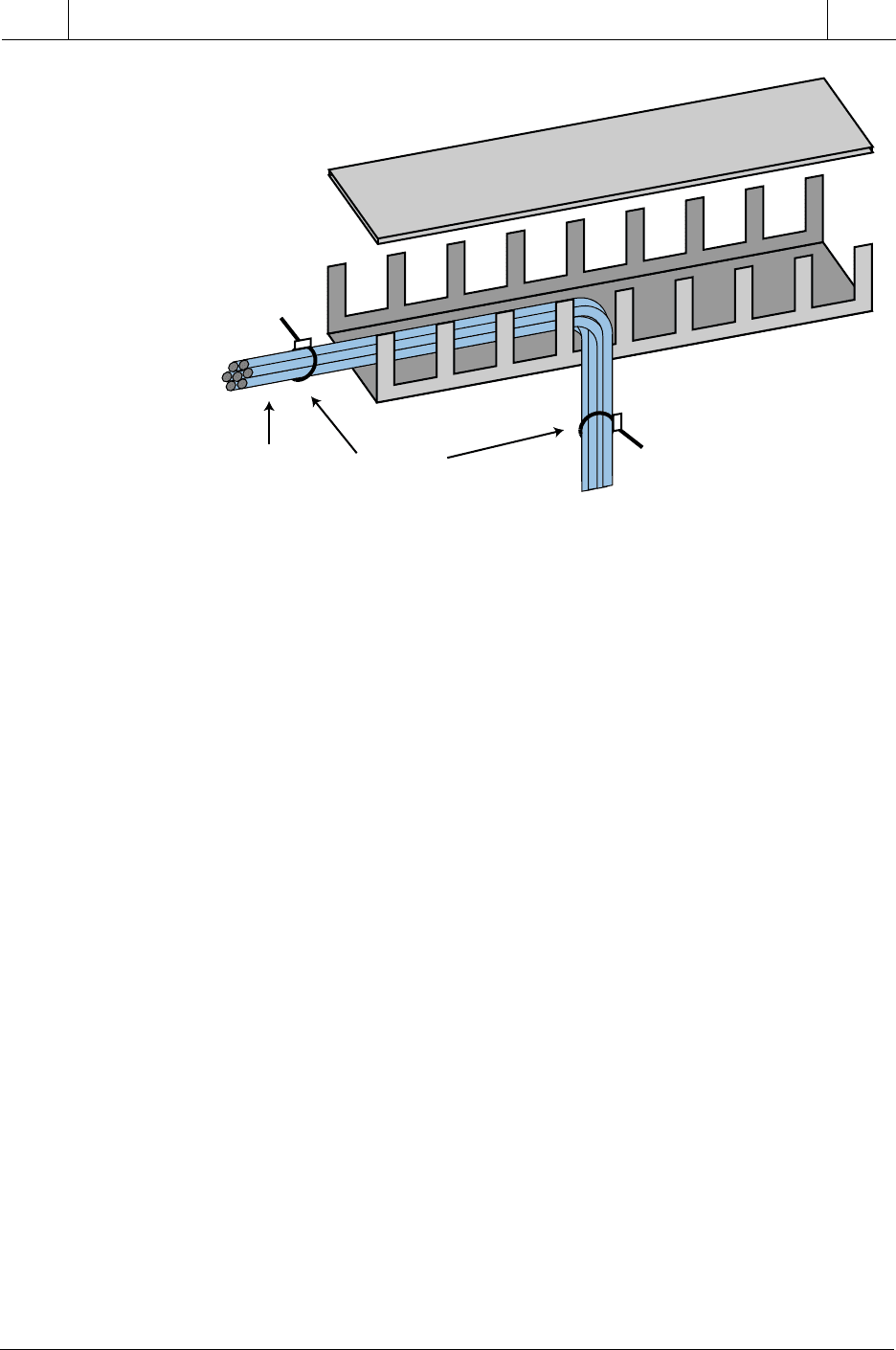
930
SECTION
6
Installation
and Start-Up
Industrial Text & Video Company 1-800-752-8398
www.industrialtext.com
CHAPTER
20
PLC Start-Up
and Maintenance
Figure 20-5. I/O wiring from a conduit.
• When designing the duct layout, the separation between the I/O
modules and any wire duct should be at least two inches. If terminal
strips are used, then the terminal strip and wire duct, as well as the
terminal strip and I/O modules, should be at least two inches apart.
Grounding. Proper grounding is an important safety measure in all electrical
installations. When installing electrical equipment, users should refer to
National Electric Code (NEC) Article 250, which provides data about the size
and types of conductors, color codes, and connections necessary for safe
grounding of electrical components. The code specifies that a grounding path
must be permanent (no solder), continuous, and able to safely conduct the
ground-fault current in the system with minimal impedance. The following
grounding practices have significant impacts on the reduction of noise caused
by electromagnetic induction:
• Ground wires should be separated from the power wiring at the point
of entry to the enclosure. To minimize the ground wire length within
the enclosure, the ground reference point should be located as close
as possible to the point of entry of the plant power supply.
• All electrical racks/chassis and machine elements should be
grounded to a central ground bus, normally located in the magnetic
area of the enclosure. Paint and other nonconductive materials should
be scraped away from the area where the chassis makes contact with
the enclosure. In addition to the ground connection made through the
mounting bolt or stud, a one-inch metal braid or size #8 AWG wire (or
the manufacturer’s recommended wire size) should be used to con-
nect each chassis to the enclosure at the mounting bolt or stud.
Plastic Conduit
Cable Tray
Conduit
Cover
I/O Wiring
Cable Tie

931
CHAPTER
20
PLC Start-Up
and Maintenance
SECTION
6
Installation
and Start-Up
Industrial Text & Video Company 1-800-752-8398
www.industrialtext.com
• The enclosure should be properly grounded to the ground bus, which
should have a good electrical connection at the point of contact with
the enclosure.
• The machine ground should be connected to the enclosure and to the
earth ground.
20-2 POWER REQUIREMENTS AND SAFETY CIRCUITRY
The source for a PLC power supply is generally single-phase and 120 or 240
VAC. If the controller is installed in an enclosure, the two power leads (L1
hot and L2 common) normally enter the enclosure through the top part of the
cabinet to minimize interference with other control lines. The power line
should be as clean as possible to avoid problems due to line interference in the
controller and I/O system.
Figure 20-6. System power supply and I/O devices with a common AC source.
POWER REQUIREMENTS
Common AC Source. The system power supply and I/O devices should
have a common AC source (see Figure 20-6). This minimizes line interfer-
ence and prevents faulty input signals stemming from a stable AC source to
the power supply and CPU, but an unstable AC source to the I/O devices. By
keeping both the power supply and the I/O devices on the same power source,
the user can take full advantage of the power supply’s line monitoring feature.
Fuse
L1
L2
L3
L1 L2
Power Supply
Power to I/O
field devices
Common to I/O
field devices
L1
L2
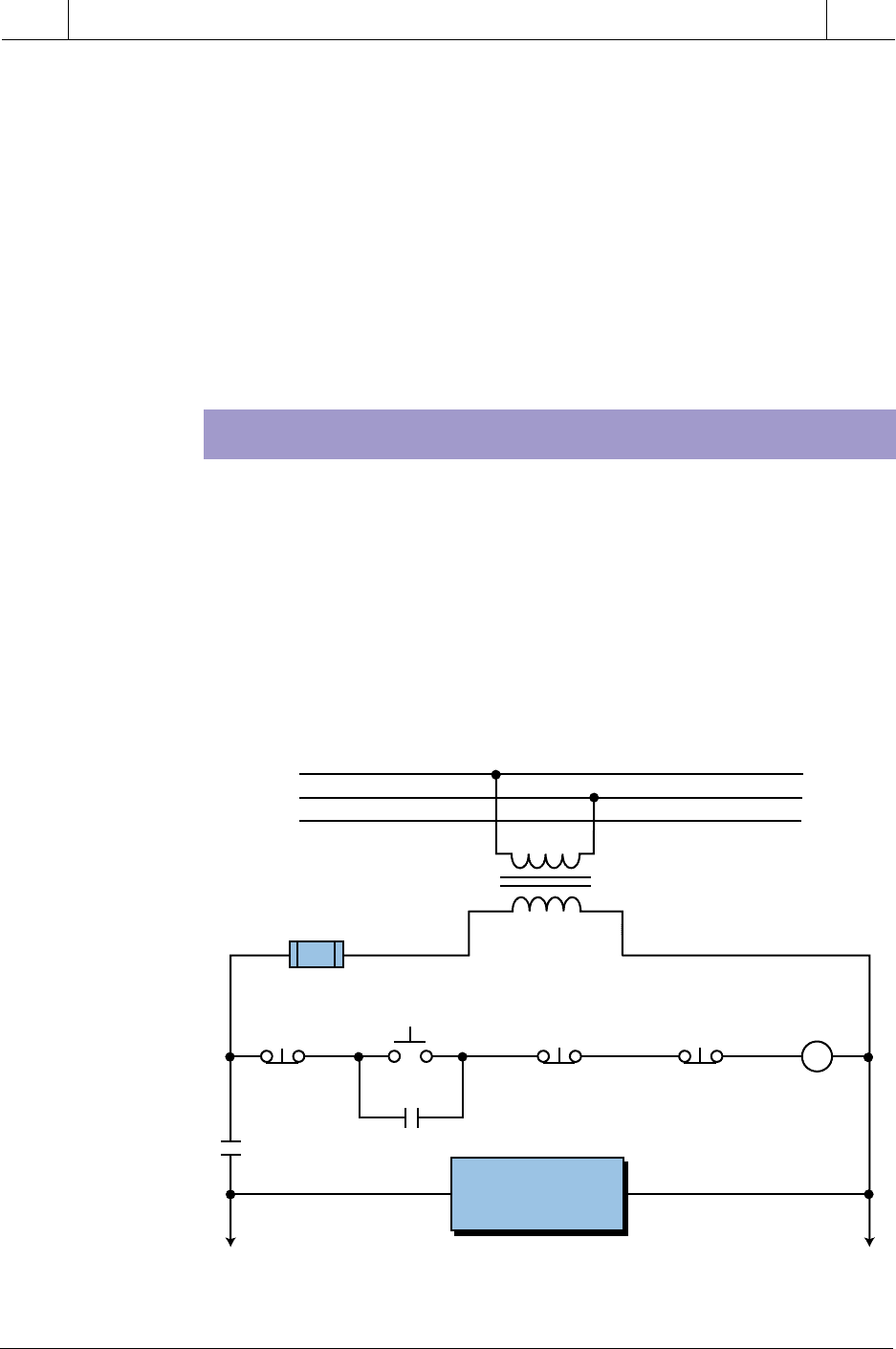
932
SECTION
6
Installation
and Start-Up
Industrial Text & Video Company 1-800-752-8398
www.industrialtext.com
CHAPTER
20
PLC Start-Up
and Maintenance
If line conditions fall below the minimum operating level, the power supply
will detect the abnormal condition and signal the processor, which will stop
reading input data and turn off all outputs.
Isolation Transformers. Another good practice is to use an isolation
transformer on the AC power line going to the controller. An isolation
transformer is especially desirable when heavy equipment is likely to intro-
duce noise into the AC line. An isolation transformer can also serve as a
step-down transformer to reduce the incoming line voltage to a desired level.
The transformer should have a sufficient power rating (in units of volt-
amperes) to supply the load, so users should consult the manufacturer to
obtain the recommended transformer rating for their particular application.
Figure 20-7. Emergency circuits hardwired to the PLC system.
SAFETY CIRCUITRY
The PLC system should contain a sufficient number of emergency circuits
to either partially or totally stop the operation of the controller or the
controlled machine or process (see Figure 20-7). These circuits should be
routed outside the controller, so that the user can manually and rapidly shut
down the system in the event of total controller failure. Safety devices, like
emergency pull rope switches and end-of-travel limit switches, should bypass
the controller to operate motor starters, solenoids, and other devices directly.
These emergency circuits should use simple logic with a minimum number
of highly reliable, preferably electromechanical, components.
Fuse
L1
L2
L3
L1 L2
To I/O To I/O
Stop PLC
System
Emergency
Stop PB1
Emergency
Stop PB2
Start PLC
System
CR1-1
CR1-2
CR1
PLC System
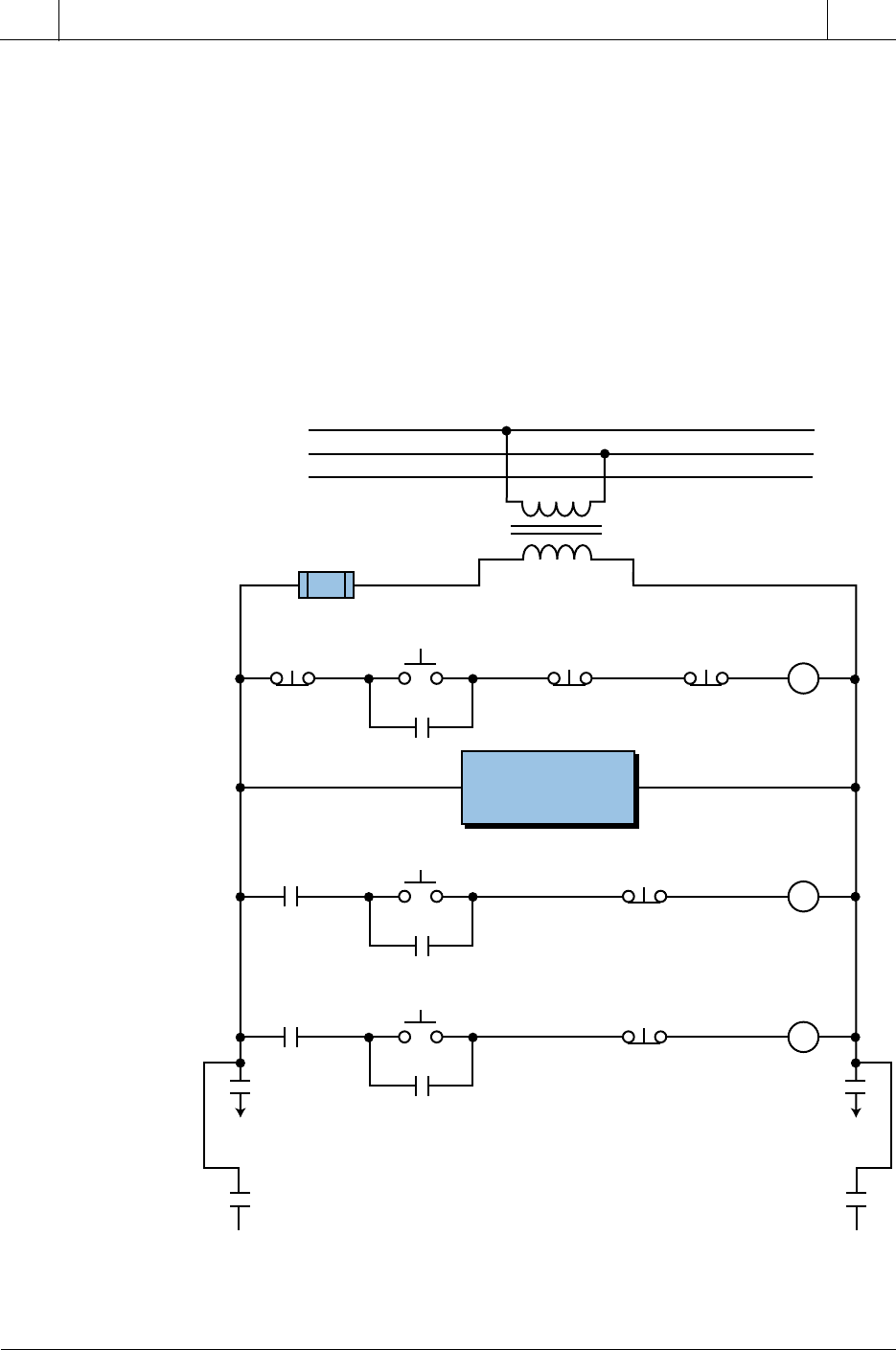
933
CHAPTER
20
PLC Start-Up
and Maintenance
SECTION
6
Installation
and Start-Up
Industrial Text & Video Company 1-800-752-8398
www.industrialtext.com
Emergency Stops. The system should have emergency stop circuits for
every machine directly controlled by the PLC. To provide maximum safety,
these circuits should not be wired to the controller, but instead should be left
hardwired. These emergency switches should be placed in locations that the
operator can easily access. Emergency stop switches are usually wired into
master control relay or safety control relay circuits, which remove power from
the I/O system in an emergency.
Master or Safety Control Relays. Master control relay (MCR) and safety
control relay (SCR) circuits provide an easy way to remove power from
the I/O system during an emergency situation (see Figure 20-8). These
control relay circuits can be de-energized by pushing any emergency stop
Figure 20-8. Master start control for a PLC with MCRs enabling input and output power.
Fuse
L1
L2
L3
L1 L2
Stop PLC
System
Emergency
Stop PB1
Emergency
Stop PB2
Start PLC
System
CR1-1
CR1-2
CR1
Enable
Input Power
Disable
Input Power
MCR1-1
MCR1
CR1-3
Enable
Output Power
Disable
Output Power
MCR2-1
MCR1-2
To Inputs
MCR2-2
To Outputs
MCR2-3
To Outputs
MCR1-3
To Inputs
MCR2
PLC System
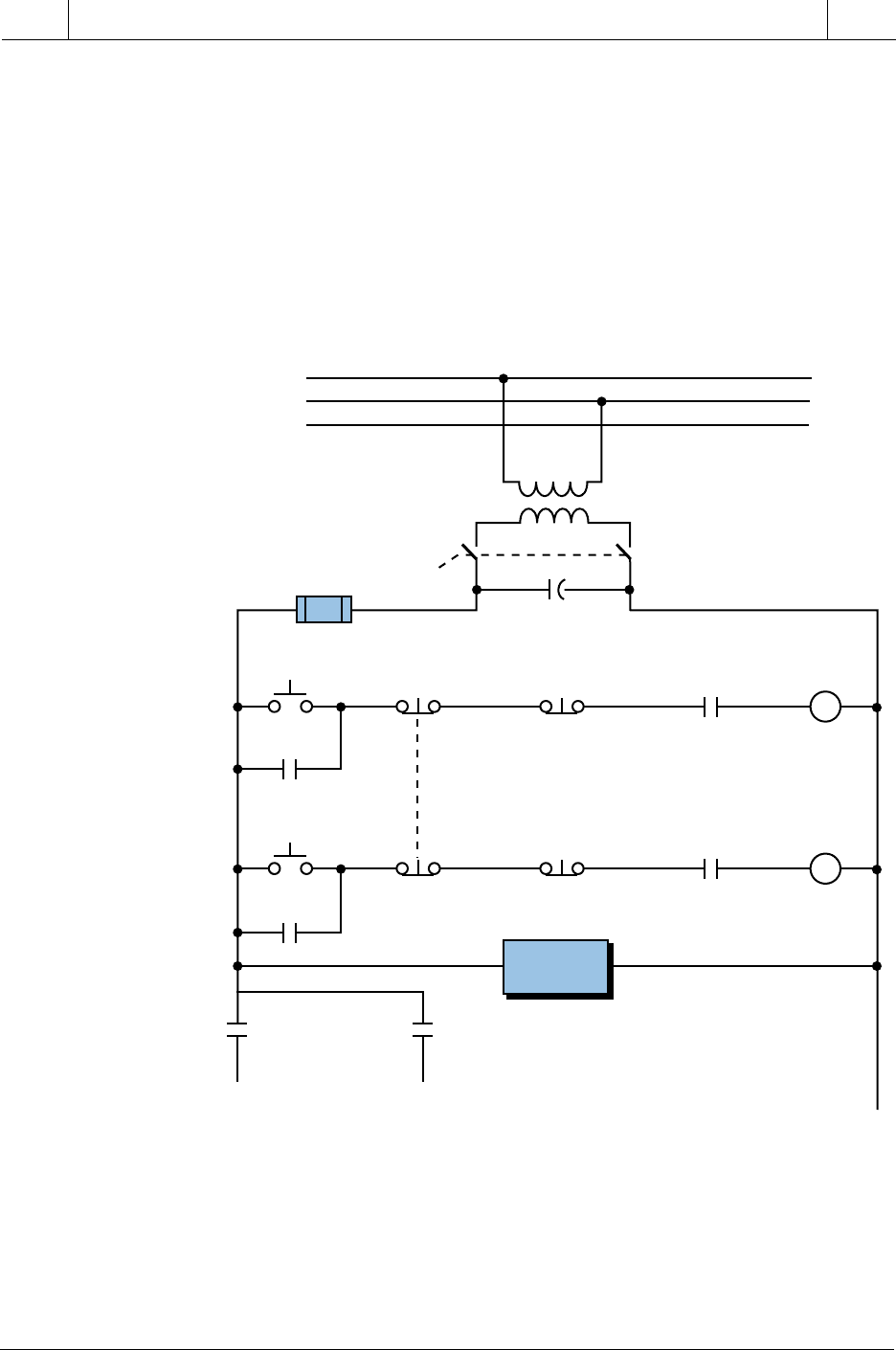
934
SECTION
6
Installation
and Start-Up
Industrial Text & Video Company 1-800-752-8398
www.industrialtext.com
CHAPTER
20
PLC Start-Up
and Maintenance
switch connected to the circuit. De-energizing the control relay coil re-
moves power to the input and output devices. The CPU, however, continues
to receive power and operate even though all of its inputs and outputs are
disabled.
An MCR circuit may be extended by placing a PLC fault relay (closed during
normal PLC operation) in series with any other emergency stop condition.
This enhancement will cause the MCR circuit to cut the I/O power in the
case of a PLC failure (memory error, I/O communications error, etc.). Figure
20-9 illustrates the typical wiring of a master control relay circuit.
Figure 20-9. Circuit that enables/disables I/O power through MCRs and PLC fault
contact detection.
Emergency Power Disconnect. The power circuit feeding the power
supply should use a properly rated emergency power disconnect, thus
providing a way to remove power from the entire programmable controller
system (refer to Figure 20-9). Sometimes, a capacitor (0.47 µF for 120 VAC,
Enable
Inputs
Emergency
Stop
Disable
Inputs
PLC Fault
Contact
Fuse
L1
L2
L3
L1 L2
PLC
C
MCR1
MCR1
Enable
Outputs
Disable
Outputs
MCR2
MCR2MCR1
MCR1 MCR2
To Inputs To Outputs
Main Disconnect

935
CHAPTER
20
PLC Start-Up
and Maintenance
SECTION
6
Installation
and Start-Up
Industrial Text & Video Company 1-800-752-8398
www.industrialtext.com
0.22 µF for 220 VAC) is placed across the disconnect to protect against an
outrush condition. Outrush occurs when the power disconnect turns off the
output triacs, causing the energy stored in the inductive loads to seek the
nearest path to ground, which is often through the triacs.
20-3 NOISE, HEAT, AND VOLTAGE REQUIREMENTS
Implementation of the previously outlined recommendations should provide
favorable operating conditions for most programmable controller applica-
tions. However, in certain applications, the operating environment may have
extreme conditions that require special attention. These adverse conditions
include excessive noise and heat and nuisance line fluctuations. This section
describes these conditions and provide measures to minimize their effects.
Excessive Noise. Electrical noise seldom damages PLC components,
unless extremely high energy or high voltage levels are present. However,
temporary malfunctions due to noise can result in hazardous machine
operation in certain applications. Noise may be present only at certain
times, or it may appear at widespread intervals. In some cases, it may exist
continuously. The first case is the most difficult to isolate and correct.
Noise usually enters a system through input, output, and power supply lines.
Noise may also be coupled into these lines electrostatically through the
capacitance between them and the noise signal carrier lines. The presence of
high-voltage or long, closely spaced conductors generally produces this
effect. The coupling of magnetic fields can also occur when control lines are
located close to lines carrying large currents. Devices that are potential noise
generators include relays, solenoids, motors, and motor starters, especially
when operated by hard contacts, such as push buttons and selector switches.
Analog I/O and transmitters are very susceptible to noise from electrome-
chanical sources, causing jumps in counts during the reading of analog data.
Therefore, motor starters, transformers, and other electromechanical devices
should be kept away from analog signals, interfaces, and transmitters.
Although the design of solid-state controls provides a reasonable amount of
noise immunity, the designer must still take special precautions to minimize
noise, especially when the anticipated noise signal has characteristics similar
to the desired control input signals. To increase the operating noise margin,
the controller must be installed away from noise-generating devices, such as
large AC motors and high-frequency welding machines. Also, all inductive
loads must be suppressed. Three-phase motor leads should be grouped
together and routed separately from low-level signal leads. Sometimes, if the
noise level situation is critical, all three-phase motor leads must be suppressed
(see Figure 20-10). Figure 20-11 illustrates line-filtering configurations
used for removing input power noise to a controller or transmitter.
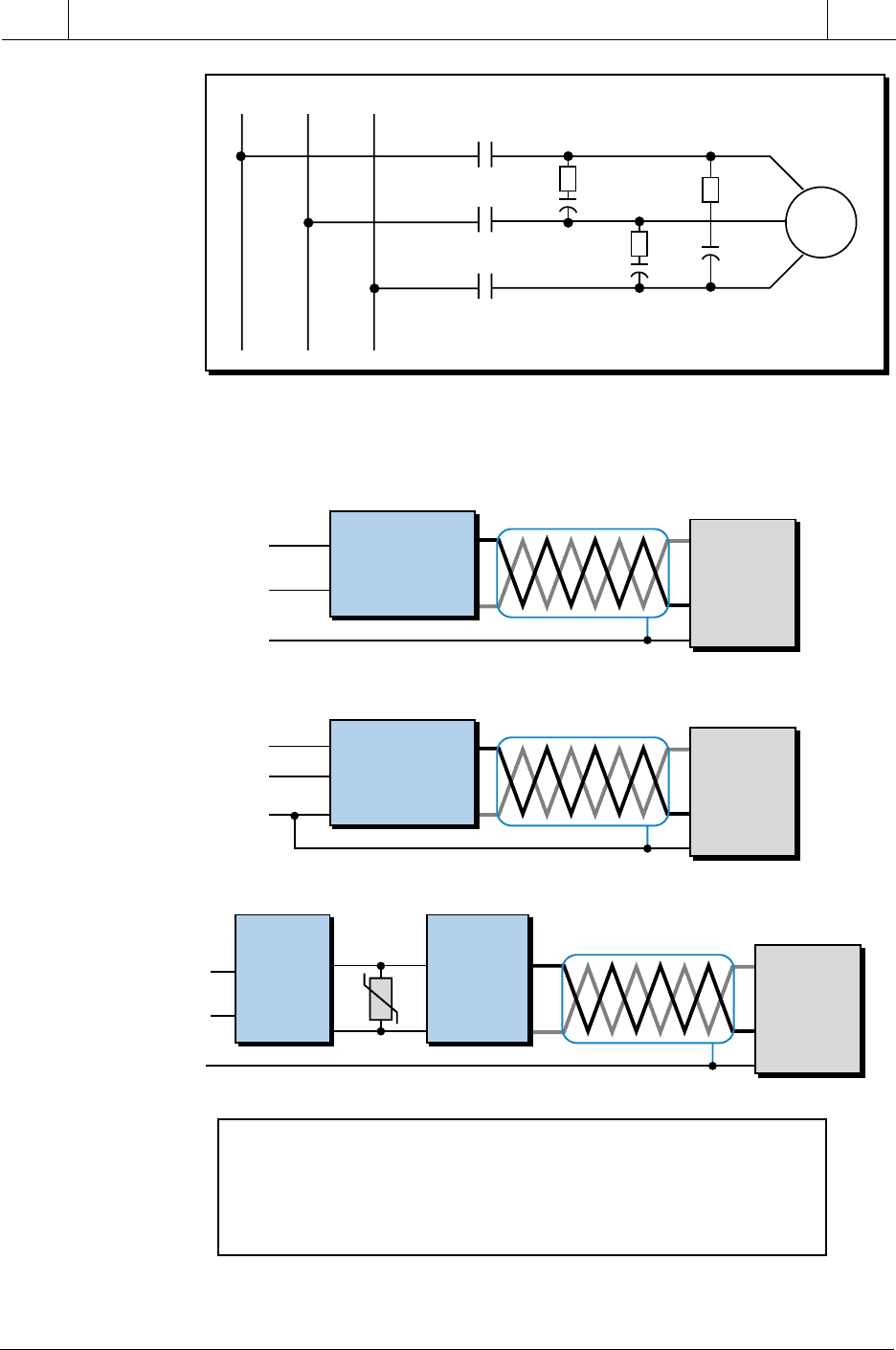
936
SECTION
6
Installation
and Start-Up
Industrial Text & Video Company 1-800-752-8398
www.industrialtext.com
CHAPTER
20
PLC Start-Up
and Maintenance
Figure 20-10. Suppression of a three-phase motor lead.
Figure 20-11. Power noise reduction using one of three line-filtering configurations.
L1 L2 L3
R
C
R
C
C
R
M
Courtesy of Watlow Electric Co., St. Louis, MO
Differential Mode
Controller
Line Load
L1
L2
Ground
Shield
L1
L2
L1
L2
(a) Differential mode filter diagram
Common Mode
Controller
Line Load
L1
L2
Ground
Shield
L1
L2
L1
L2
(b) Common mode filter diagram
Common
Mode
Controller
L1
L2
Ground
Shield
L1
L2
L1
L2
(c) Combination differential/common mode filter diagram
Line Filter
Differential
Mode
L1
L2
Line Load
Line Filter
Line Filter
MOV
Note 1: Keep line filters 12 inches or less from the controller. Minimize the line
distance where noise can be introduced into the controller.
Note 2: To prevent ground loops, do not tie the common mode line metal case
filters with other metal that is at ground potential. Doing so will reduce
the filters’ effectiveness.

937
CHAPTER
20
PLC Start-Up
and Maintenance
SECTION
6
Installation
and Start-Up
Industrial Text & Video Company 1-800-752-8398
www.industrialtext.com
Excessive Heat. Programmable controllers can withstand temperatures
ranging from 0 to 60°C. They are normally cooled by convection, meaning
that a vertical column of air, drawn in an upward direction over the surface of
the components, cools the PLC. To keep the temperature within limits, the
cooling air at the base of the system must not exceed 60°C.
The PLC components must be properly spaced when they are installed to
avoid excess heat. The manufacturer can provide spacing recommendations,
which are based on typical conditions for most PLC applications. Typical
conditions are as follows:
• 60% of the inputs are ON at any one time
• 30% of the outputs are ON at any one time
• the current supplied by all of the modules combined meets manufac-
turer-provided specifications
• the air temperature is around 40°C
Situations in which most of the I/O are ON at the same time and the air
temperature is higher than 40°C are not typical. In these situations, spacing
between components must be larger to provide better convection cooling. If
equipment inside or outside of the enclosure generates substantial amounts of
heat and the I/O system is ON continuously, the enclosure should contain a
fan that will reduce hot spots near the PLC system by providing good air
circulation. The air being brought in by the fan should first pass through a
filter to prevent dirt or other contaminants from entering the enclosure.
Dust obstructs the components’ heat dissipation capacity, as well as harms
heat sinks when thermal conductivity to the surrounding air is lowered. In
cases of extreme heat, the enclosure should be fitted with an air-conditioning
unit or cooling control system that utilizes compressed air (see Figures 20-12
and 20-13). Leaving enclosure doors open to cool off the system is not a good
practice, since this allows conductive dust to enter the system.
Figure 20-12. Vortex cooler used in cooling systems.
Courtesy of ITW Vortec, Cincinnati, OH

938
SECTION
6
Installation
and Start-Up
Industrial Text & Video Company 1-800-752-8398
www.industrialtext.com
CHAPTER
20
PLC Start-Up
and Maintenance
EXAMPLE 20-1
The NEMA 12 enclosure shown in Figure 20-15 contains a program-
mable controller with a power supply transformer, power supplies for
an analog transmitter and other equipment, and various electrome-
chanical equipment. The combined power dissipation of the equip-
ment, found by adding each element’s power dissipation, is 1011
watts. The ambient temperature of the enclosure is 90°F (32.2°C). Find
(a) the temperature rise for this enclosure and (b) the required airflow.
There are methods available to calculate the temperature rise and heat
dissipation requirements of an enclosure based on its size and equipment
contents. Temperature rise is the temperature difference between the air
inside an enclosure and the outside air temperature (ambient air temperature).
Hoffman Engineering Co., a manufacturer of control system enclosures, has
developed temperature rise graphs for use with their panels and enclosures.
Figure 20-14 illustrates a temperature rise graph for a NEMA 12–type
enclosure. The following example illustrates how to calculate temperature
rise and required airflow using the graph.
Figure 20-13. Compressed air cooling system.
Courtesy of ITW Vortec, Cincinnati, OH
Basic Cooler
Solenoid Valve
(750 & 790 only)
Filter
Compressed
air inlet line
Ducting
Kit
Adjustable
Thermostat
(759 & 790 only)
